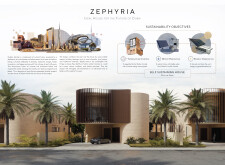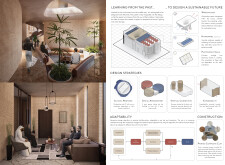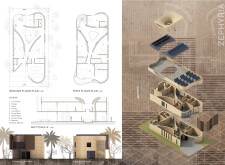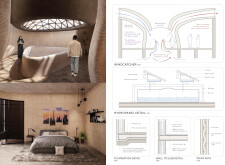5 key facts about this project
### Overview
Located in Dubai, Zephyria represents a thoughtful integration of historical and modern architectural influences, designed to address the future demands of the region. Drawing from the cultural richness of the area, the residence combines traditional Middle Eastern elements, such as wind towers, with contemporary construction techniques and materials. This project aims to create a living environment that honors local heritage while embracing technological advancements.
### Materiality and Sustainability
The choice of materials in Zephyria reflects a commitment to sustainability and adaptability within Dubai's climate. Key components include printed composite clay, known for its structural integrity and thermal efficiency, and photovoltaic panels on the roof that capture solar energy for sustainable power generation. Additionally, hydropanels are incorporated to extract moisture from the air, providing a reliable water supply. Strategic use of glass throughout the design enhances natural lighting while contributing to energy efficiency. Properties such as improved thermal insulation are prioritized to regulate indoor temperatures effectively.
### Innovative Design Strategies
Zephyria employs innovative design strategies to promote both functionality and sustainability. Passive design elements, including windcatchers, facilitate natural ventilation, reducing dependence on mechanical cooling systems. The project's water harvesting system complements traditional storage methods, ensuring a consistent water supply in a region characterized by irregular rainfall. The flexible spatial arrangement encourages social interaction while preserving privacy, with fluid layouts optimizing natural light and ventilation. The design also incorporates a staircase that enhances vertical connectivity, linking different levels of the home to foster ongoing engagement among occupants.






















































